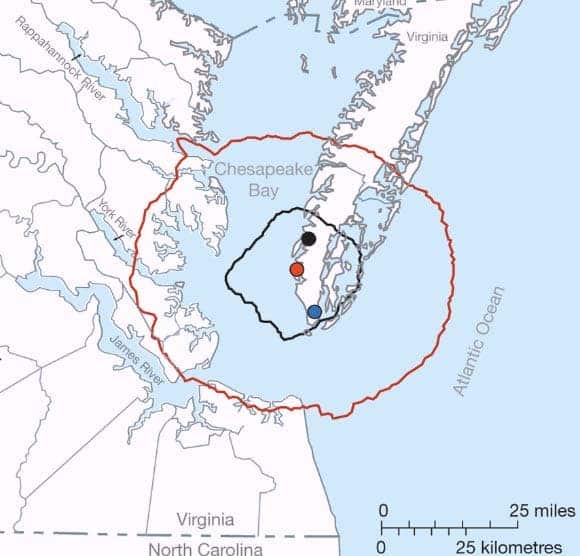- Chesapeake Bay is one of the few oceanic impact craters on Earth
- When the huge impact took place ~35 million years ago, it sealed the ancient oceanic water
- The water has remained virtually unchanged since then
A new study published in Nature provides chemical, isotopic and physical evidence that groundwater found at about 1.5 km deep under the Chesapeake Bay is actually a 145 million year old remnant of the Cretaceous North Atlantic Sea.

Metaphorically speaking, the aquifer described is just like a very ancient fly trapped in amber – preserving the exact conditions of the time it was sealed; the water is two times more salty than modern saltwater, providing valuable information about Cretaceous salinity. The entire setting was created with the “help” of a massive comet or meteorite that struck the area, its impact basically creating Chesapeake Bay.
“Previous evidence for temperature and salinity levels of geologic-era oceans around the globe has been estimated indirectly from various types of evidence in deep sediment cores. In contrast, our study identifies ancient seawater that remains in place in its geologic setting, enabling us to provide a direct estimate of its age and salinity,” said lead author Dr Ward Sanford of U.S. Geological Survey.
Chesapeake Bay is one of only a few impact craters that have been identified and described in oceanic waters. It’s estimated that the impact took place some 35 million years ago, ejecting enormous quantities of debris and creating humongous tsunamis that probably reached as far as the Blue Ridge Mountains, over 150 km away. This study not only highlights an underground structure that can provide valuable information about the marine environment from the Cretaceous, but it also helped geologists better understand the Chesapeake Bay itself.
“This study gives us confidence that we are working directly with seawater that dates far back in Earth’s history,” said Jerad Bales, acting U.S. Geological Survey’s Associate Director for Water. “The study also has heightened our understanding of the geologic context of the Chesapeake Bay region as it relates to improving our understanding of hydrology in the region.”
So how exactly was the aquifer preserved? Well generally speaking, an aquifer is an underground layer of water-bearing permeable rock or unconsolidated materials (gravel, sand, or silt), trapped between impermeable rocks. You can think of is basically as a wet sponge in a horizontal bottle – the sponge is the permeable rocks holding water, the bottle is the layers of impermeable rock. When the big impact took place, it created such an impermeable layer, trapping the ancient water beneath it.
Researchers had a hunch that they might find something interesting there by drilling boreholes, but they had no idea just how interesting things would get.
Scientific Reference: Evidence for high salinity of Early Cretaceous sea water from the Chesapeake Bay crater. Ward E. Sanford, Michael W. Doughten, Tyler B. Coplen, Andrew G. Hunt & Thomas D. Bullen. Nature 503, 252–256 doi:10.1038/nature12714






